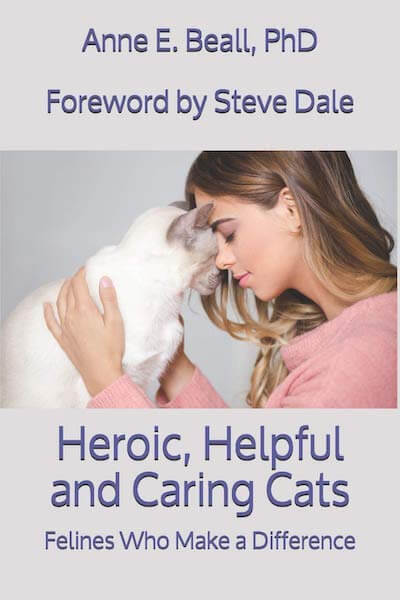By Anne E. Beall, PhD

Today on The D Lit Blog, we’re posting an excerpt from author Anne E. Beall, PhD’s book Heroic, Helpful and Caring Cats: Felines Who Make a Difference.
Book excerpt
In order to understand the role that cats play in Americans’ lives, we conducted a survey of a representative sample of the U.S. population. We surveyed 1,507 people who have lived with a cat, either currently or as an adult. We asked them to tell us about the favorite cats in their lives and what they felt about each one. We also asked about their attitudes toward stray and feral cats.
My firm, Beall Research, conducts qualitative and quantitative research for Fortune 500 companies. We conduct surveys on a variety of topics, although not usually on cats. Below are the findings from this study.
Cats in the Home
Among adults who have lived with a cat, more than three-fifths of them currently have a cat and over half have a dog. Other pets, such as ferrets, mice, birds, and rabbits, are rarer. Approximately 8 in 10 respondents currently live with 1-2 cats in their household. Over half (55%) of respondents have had 1-2 cats as an adult and the remainder have had 3 or more cats during their adult years.
Communication and Intelligence
We asked survey respondents to tell us about one to three favorite cats they’ve had as an adult. Approximately 60% of the cats that respondents described were currently living with them at the time of the survey. There were 1,507 respondents who answered questions about 3,169 cats. Thus, we were able to understand over 3,000 cats and over 3,000 cat-human relationships. We asked several questions about each cat: how close the person felt to each feline, how much communication occurred, and in what ways the cat and the person had helped one another.
The first question we asked was how intelligent each cat is compared to other animals. Two-thirds of these cats are perceived to be extremely intelligent compared to other animals. We then asked how intelligent the cat is compared to humans, and one- third of these favorite cats were believed to be extremely intelligent relative to people. We also asked how much communication occurs between the caretaker and the cat, and we learned that over half (59%) of these relationships have a tremendous amount of communication. Only 4% have no communication.
When asked how well the cats read their caretaker’s feelings and preferences, over half of these cats appear to read the person extremely well. This finding is not in line with stereotypes of cats as aloof and disinterested. Only 4% of cats did not read their caretaker well at all. Given that communication is a two-way street, we inquired how well the caretaker reads the feelings and preferences of the cat. Apparently, it’s similar to how well the cat reads the person.
We found that in general the amount of communication between the caretaker and cat was highly correlated with how well the cat and person read one another, as well as the level of closeness with the cat. Thus, both talking to your cat and listening to their communications leads to greater closeness and a greater ability to read the feline.
Relationship and Helping
We then asked how close the person feels to each cat. Given the amount of communication that occurs between cats and caretakers, it’s not surprising that over three-quarters (77%) feel extremely close to the cat.
We were curious how people help their cats, so we provided a list of common ways that people assist cats and asked if they had helped their cat in any of these ways. Interestingly, playing with the cat and providing them with companionship and comfort were among the top ways that the person helped a cat. These responses suggest that the human-cat bond is strong, and that people are doing things they feel their cat appreciates.
We also asked how the cat had helped them and the most common response was that the cat made the person happy. Other popular responses were that the cat provided companionship, loved their caretaker unconditionally, was a friend, or was someone whom they could cuddle or hug. Although cats are often stereotyped as being aloof, it’s clear they’re not.
Anne E. Beall, PhD is the CEO and Founder of Beall Research, Inc, a consulting firm that uses data and research to discover trends and create solutions for Fortune 500 companies. Author of Cinderella Did Not Live Happily Ever After and 6 other books on fairy tales, gender dynamics, human-animal relations, and market research, Anne previously worked for the Boston Consulting Group (BCG) and National Analysts. She received her MS, MPhil, and PhD from Yale University. A lover of cats, storytelling, and running, Anne lives in Chicago.
